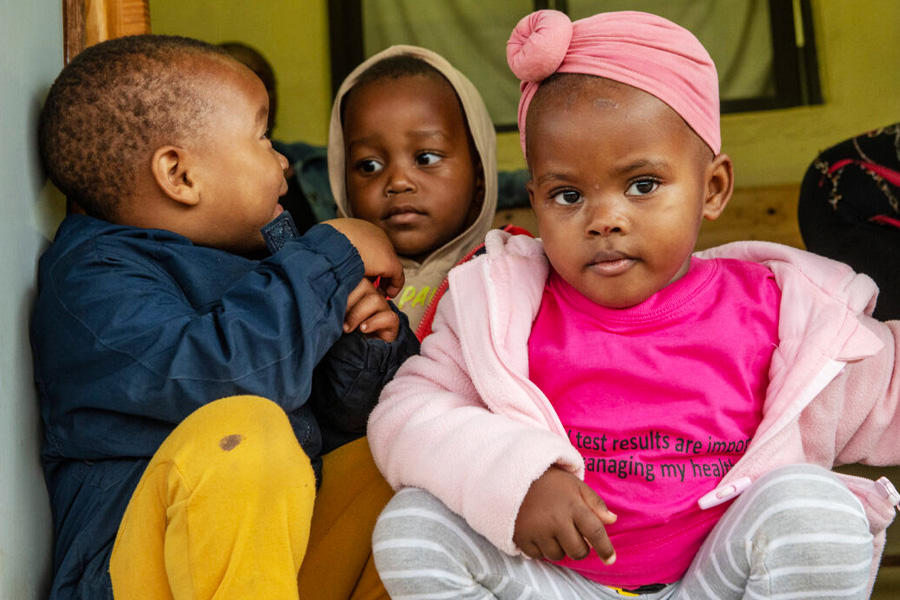Note: Eswatini—an independent kingdom on South Africa’s eastern border—was known as Swaziland prior to 2018, when it officially reclaimed its traditional name.
The global fight to end AIDS means including and prioritizing children and adolescents. In 2022, children accounted for 13% of AIDS-related deaths last year, even though they comprise only about 4% of people living with HIV globally. And while significant progress has been made in ending HIV in adult populations, children are being left behind—57% of children living with HIV are receiving antiretroviral therapy compared to 77% of adults. Closing the gaps between adults and children is critical in achieving an AIDS-free generation.
When Felicity Maya began her nursing career 20 years ago, she walked into the center of Eswatini’s raging HIV epidemic—with few weapons to fight the deadly virus. After graduating from the University of Swaziland in 2003, Maya was posted to the Mankayane Government Hospital, working primarily with pregnant women and babies. There was no method readily available for preventing HIV transmission from mothers to their babies.
In 2003, Eswatini had the highest HIV prevalence in the world. Four in ten adults, including pregnant women, were estimated to be living with HIV. Sixty-four percent of Eswatini deaths in 2002 were due to AIDS-related illness, according to the World Health Organization. Maya remembers the stress that health workers faced in those days.
“We even lost lots of staff members,” says Maya. “It was too much, emotionally.”
Maya recalls one of her first young patients: “I think she was around 3 or 4 years old. She was HIV-positive, [but] there were no ARVs [antiretroviral medications] at that time. She had been taking antibiotics for some time.” However, antibiotics are not ARVs, and they are inadequate to fight off advanced HIV disease, AIDS, but they were the best tool available in Eswatini at that time to prolong a life.
“There came a time when she told us, ‘Please, I don't want the [antibiotic] injections again. Mommy has already told me that the angels will be coming to pick me up at night.’ We convinced her that we should take the medication—but then we didn't find her the next morning.” She had died that night.
“That was really something that I took from then until today. It was so painful to lose her because we were so close to her. We really thought that maybe she would have some few [more] days with us. But then she didn't [survive].”
This small girl, like nearly all HIV-positive children, had acquired HIV during pregnancy, childbirth, or breastfeeding. At the time, there were no means to prevent mother-to child transmission (PMTCT) of HIV in Eswatini.
“It was very difficult because most of the [pregnant women] didn't even know about their [HIV] status,” says Maya. “The baby might [appear to be] healthy, but the mom is already ill, and she dies. Then the baby is left with the grandmother, and you get the baby coming back to the hospital again. Most of them would die.
‘It has become better, and we should be able to celebrate that—but let's not become too complacent. Our children are still not getting the optimal formulations that we want them to get.’
“It was such a burden because you will go home thinking, ‘When I go back to the hospital, I will not find that baby. I will not find that woman.’”
“When the HIV era hit us as a country, we didn't know what to do. It’s [obviously] not a good thing to have people dying—to have mothers dying, to have children dying—because you can actually see that the country will not have a future. There will not be any more adults in the long run.”
PMTCT: The light at the end of the tunnel
In the same year that Maya began her career, President George W. Bush announced a new global investment in HIV prevention and treatment called the President’s Emergency Fund for AIDS Relief (PEPFAR) that was approved by Congress. Also in 2003, the Elizabeth Glaser Pediatric AIDS Foundation (EGPAF) began working in Eswatini—through PEPFAR and other funding partners—to quickly change the narrative from despair to hope by preventing HIV transmission from mothers to babies and by making ARVs available for mothers and children living with HIV.
“It was the breakthrough,” says Maya. “It was a relief. At least we could do something. We may have some children born with HIV, but most children would not have HIV if the mom had taken the [PMTCT] prophylaxis at that time when she was in labor.
“When you are pregnant, and you discover that you are HIV-positive, you want to see a light at the end of the tunnel,” says Maya.
“In that first phase, we were able to scale up PMTCT services from just three facilities in 2004 to 100% of public health facilities by the end of 2010,” says EGPAF-Eswatini country director Caspian Chouraya, MD.
“We had very good outcomes,” says Dr. Chouraya. “We saw uptake of HIV testing services rise dramatically so that 97% of pregnant women would deliver knowing their HIV status by around 2010. More than 95% of those women who happened to be HIV positive were receiving some kind of treatment to prevent mother-to-child HIV transmission.”
“We were the go-to partner for anything to do with prevention of mother-to-child HIV transmission [PMTCT],” Dr. Chouraya says. “Even now, once you say EGPAF, people think PMTCT, and once you say PMTCT, people just look at EGPAF.”
Comprehensive HIV services transform a nation
“Having achieved so much with PMTCT, we began moving out of our comfort zone around 2010,” says Dr. Chouraya. “We started implementing comprehensive HIV services—testing, treatment, TB services—services that ensure that all people are retained in care. And we broadened our clientele from just a focus of mothers and their babies to the entire family, including men and adolescents.”
Maya explains that pediatric HIV programs have a responsibility to not only prevent HIV transmission from mother to child, but to ensure that every child has the resources to grow up healthy. This means that a mother living with HIV is guaranteed access to ARVs for life. It means that men have an active role in their family’s healthcare. It means that the special health needs of adolescents are recognized and addressed.
Through the comprehensive approach, Eswatini has been transformed.
In 2021, Eswatini surpassed the 95-95-95 goals set by UNAIDS: 95% of the total population knows their HIV status, 95% of people who test positive are enrolled in ART, and 95% of them enrolled in ART are virally suppressed. While Eswatini still has the highest HIV prevalence in the world—one in four adults are living with HIV—it represents a population where people are living with HIV instead of dying from HIV-related disease.
Now is the time for an AIDS-free generation
These days, Maya rarely sees a baby who is born with HIV, thanks to the success of PMTCT and comprehensive HIV services. But 1,200 children in this small nation still acquire HIV each year—either in childbirth or through some other means. AIDS remains the leading cause of death for children under the age of five.
“We're seeing that there have been huge improvements,” says Dr. Chouraya. “However, there's still a gap when we compare adults and children. It has become better, and we should be able to celebrate that—but let's not become too complacent. Our children are still not getting the optimal formulations that we want them to get. Our children are still not being diagnosed at a rate we want them to be diagnosed.”
EGPAF-Eswatini has entered a third phase that focuses reaching the children who remain underserved and transitioning some HIV services to the Ministry of Health for long-term sustainability. This is the phase for completing the task that EGPAF embarked on a generation ago in Eswatini.
“Yes, it's better than what it was 20 years ago—and I'm happy we've been part of that—but we still need to make sure that this gap is closed until as we say, no children are left behind," says Dr. Chouraya. “Now is the time to finish the fight for an AIDS-free generation.”
Today, Maya is the senior nurse at Sigangeni Clinic in rural Eswatini. She enjoys engaging with a generation of adolescents who are alive and healthy because of concentrated global efforts to address HIV in the country hardest hit by the pandemic.
“I've been practicing [medicine] for more than 20 years,” she says. “Most of the children from when I started are grown up now. It's so satisfying seeing that you delivered this baby, and you did all that you could for that baby to be alive. And then the mothers are always grateful for the rest of their lives. Even though we grow old, they never forget our faces.
“And then this [child] is now a nurse," she says, as she considers passing the torch. “I will die knowing that I did my best. I will die knowing that I'm a legend. I really did something when there was work to be done.”
The Elizabeth Glaser Pediatric AIDS Foundation is a global leader in the fight to end HIV in children. EGPAF-Eswatini is currently supported by the United Agency for International Development (USAID) under the ASPIRE Project and supports 78 health facilities in the Shiselweni and Hhohho regions of Eswatini.



